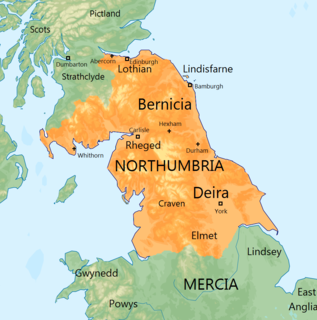| Hering | |
|---|---|
| Born | Late 6th century |
| Died | Early 7th century |
| Father | Hussa of Bernicia |
Hering, son of Hussa (late 6th century-early 7th century) was a Bernician prince. He was the son of Hussa, king of Bernicia from 585 to 592 or 593. After Hussa's death the kingdom went to Æthelfrith, Hering's cousin. During the first half of Æthelfrith's reign, Hering fled to Dál Riata, where he was given refuge by their king, Áedán mac Gabráin.
Bernicia was an Anglo-Saxon kingdom established by Anglian settlers of the 6th century in what is now southeastern Scotland and North East England.
Hussa was the seventh known ruler of the Anglo-Saxon kingdom of Bernicia, ruling for seven years from about 585 to about 592.

Dál Riata or Dál Riada was a Gaelic overkingdom that included parts of western Scotland and northeastern Ireland, on each side of the North Channel. At its height in the late 6th and early 7th centuries, it encompassed roughly what is now Argyll in Scotland and part of County Antrim in the Irish province of Ulster.
In 603, Hering led a part of a Dalriadan army to attack Bernicia, but was defeated at the Degsastan by Æthelfrith: the Anglo-Saxon Chronicle (manuscript E, year 603) mentions Hering's participation, although Bede does not. Hering's ultimate fate is unknown.
The Battle of Degsastan was fought around 603 between king Æthelfrith of Bernicia and the Gaels under Áedán mac Gabráin, king of Dál Riada. Æthelfrith's smaller army won a decisive victory, although his brother Theodbald was killed. Very little further is known about the battle. The location of the nominal Dagsastan is not known, either; Dawstane in Liddesdale, Scotland, is a possibility.

The Anglo-Saxon Chronicle is a collection of annals in Old English chronicling the history of the Anglo-Saxons. The original manuscript of the Chronicle was created late in the 9th century, probably in Wessex, during the reign of Alfred the Great. Multiple copies were made of that one original and then distributed to monasteries across England, where they were independently updated. In one case, the Chronicle was still being actively updated in 1154.

Bede, also known as Saint Bede, Venerable Bede, and Bede the Venerable, was an English Benedictine monk at the monastery of St. Peter and its companion monastery of St. Paul in the Kingdom of Northumbria of the Angles. Born on lands likely belonging to the Monkwearmouth monastery in present-day Sunderland, Bede was sent there at the age of seven and later joined Abbot Ceolfrith at the Jarrow monastery, both of whom survived a plague that struck in 686, an outbreak that killed a majority of the population there. While he spent most of his life in the monastery, Bede travelled to several abbeys and monasteries across the British Isles, even visiting the archbishop of York and King Ceolwulf of Northumbria. He is well known as an author, teacher, and scholar, and his most famous work, Ecclesiastical History of the English People, gained him the title "The Father of English History". His ecumenical writings were extensive and included a number of Biblical commentaries and other theological works of exegetical erudition. Another important area of study for Bede was the academic discipline of computus, otherwise known to his contemporaries as the science of calculating calendar dates. One of the more important dates Bede tried to compute was Easter, an effort that was mired with controversy. He also helped establish the practice of dating forward from the birth of Christ, a practice which eventually became commonplace in medieval Europe. Bede was one of the greatest teachers and writers of the Early Middle Ages and is considered by many historians to be the single most important scholar of antiquity for the period between the death of Pope Gregory I in 604 and the coronation of Charlemagne in 800.





